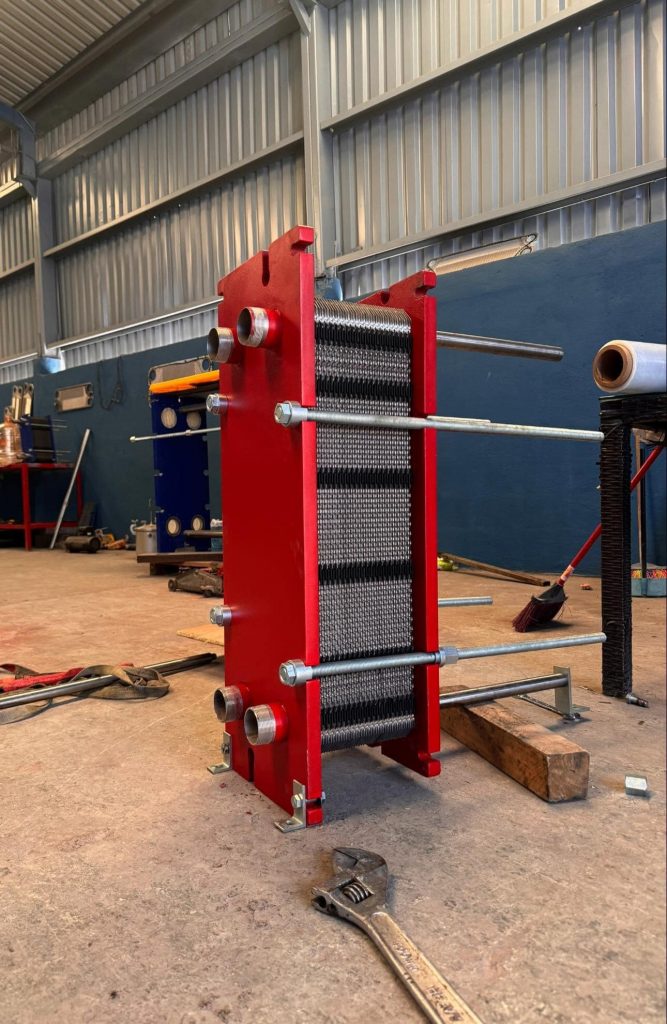Material of Construction of plate heat exchanger?
The Material of Construction (MOC) for a plate heat exchanger is a critical selection criteria, as it directly impacts the unit’s performance, longevity, and cost. The choice is primarily driven by the fluids being processed, their temperature, concentration, and presence of chlorides.
The main components to consider are the Plates and the Gaskets.
1. Plate Materials
Plates are typically made from stainless steel or specialized alloys to resist corrosion. The thinness of the plates means even minor corrosion can lead to failure.
| Material | Typical Grade | Key Properties | Common Applications |
| Stainless Steel | AISI 304 | Good general corrosion resistance, cost-effective. | City water, closed circuit loops, non-aggressive fluids, mild chemicals. |
| AISI 316 / 316L | The most common choice. Excellent corrosion resistance due to Molybdenum content, which resists pitting. | Cooling tower water, seawater, brines, food products (milk, beer), many process chemicals. | |
| AISI 304 / 316 with Nickel coating | Electroless nickel plating adds a protective layer. | Extends life in aggressive waters, provides a barrier against corrosion. |
| Nickel Alloys | Hastelloy | Exceptional resistance to a wide range of acids and chlorides, even at high temperatures. | Highly corrosive chemicals, sulfuric & hydrochloric acid, severe environments. |
| Inconel | Excellent resistance to oxidation and high-temperature corrosion. | High-temperature applications, concentrated caustic solutions. | |
| Alloy 254 SMO | Very high Molybdenum content for superior resistance to chloride pitting and crevice corrosion. | Seawater, bleach plants (pulp & paper), harsh chemical environments. | |
| Titanium | Grade 1 / 2 | Excellent corrosion resistance, especially to chlorides and seawater. Outstanding for seawater. | Seawater cooling, brackish water, chlorinated water, food acids. |
| Palladium-Stabilized Titanium | More resistant to acidic conditions than pure titanium. | Acids (e.g., nitric acid), more aggressive chemical services. | |
| Titanium-Palladium Alloy | Grade 7 / 11 | Superior to pure titanium in reducing acids. Expensive. | Highly oxidizing and reducing acid environments. |
| Other Materials | Graphite | Excellent thermal conductivity and resistance to almost all corrosives. | Highly corrosive acids (e.g., hydrochloric) where metals fail. Brittle. |
| Tantalum | One of the most corrosion-resistant metals, similar to glass. Very expensive. | Ultimate solution for extremely aggressive chemicals, like hydrochloric acid. |
Key Consideration for Stainless Steels: Chloride Stress Corrosion Cracking (CLSCC)
Stainless steels (especially 304 and 316) are susceptible to CLSCC in the presence of:
- Chlorides (in water or fluid)
- Tensile Stress (from the clamped plates)
- Elevated Temperature (risk increases significantly above ~60°C / 140°F)
If these three factors are present, a more resistant alloy like Titanium or Hastelloy may be required.
2. Gasket Materials
Gaskets are just as important as the plates. A leak will occur if the gasket fails, even if the plates are perfect. Gasket selection is based on fluid compatibility, temperature, and pressure.
| Material | Abbreviation | Temperature Range (Approx.) | Key Properties | Common Applications |
| Nitrile Butadiene Rubber | NBR | -15°C to +110°C (up to 130°C) | Good resistance to oils, fats, aliphatic hydrocarbons. Low cost. | The most common gasket. Water, oils, glycols, refrigerants, diesel fuel. |
| Ethylene Propylene Diene Monomer | EPDM | -50°C to +150°C (up to 170°C) | Excellent resistance to hot water, steam, alkalis, and polar solvents. Poor with oils. | Hot water, steam, heating systems, caustic solutions, alkalis. |
| Fluoroelastomer | FKM / Viton® | -20°C to +180°C | Excellent resistance to high temperatures, oils, acids, and aliphatic & aromatic hydrocarbons. | High-temperature fluids, aggressive chemicals, acids, refined fuels. |
| Compressed Asbestos-Free | CAF | Up to 260°C | High temperature and pressure resistance. Good chemical resistance. | Superheated steam, high-temperature oils. Less common due to handling. |
| Hydrogenated Nitrile Butadiene Rubber | HNBR | -40°C to +150°C | Similar to NBR but with better heat, ozone, and chemical resistanc |
